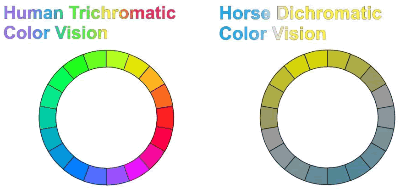Understanding Horse Vision:
by Rick Gore
Horses have very unique eyes. They  can see out of one eye and each eye can see something different or independently. The left can see on the left while the right is seeing something different on the right, this is one reason why they spook so easy and jump and react to changes around them.
can see out of one eye and each eye can see something different or independently. The left can see on the left while the right is seeing something different on the right, this is one reason why they spook so easy and jump and react to changes around them.
Humans cannot do this so it is hard for them to see the world through a horse’s eyes. Using one eye at a time is called Monocular Vision. [Mono meaning one]
Which is why a horse can almost see all the way around their bodies, to spot predators and other dangers so they can react, run, flight and survive or live. Understanding this behavior is normal and not spooky or crazy will help you to STOP blaming or labeling your horse.
A horse is only a horse and that is all it knows how to be. Being aware of this fact will save you from getting kicked, when a horse’s head is down looking in front of him and he is not looking around him, when things pop up from their blind side, it startles them and they react instinctively by kicking or running.
Horses need to be able to move their heads up and down in order to focus on things on the ground and in front of them (also to use for balance and counter balance but that is another topic). A horse’s depth perception is dependent on them using their head movement to focus on things far and close.
So when some riders keep the bit so tight that it keeps a horse’s head tucked low and bent into their chest, because it looks cool or gets them points in a show, it takes away the ability of the horse to focus on things.
This can cause a horse to trip (they can’t balance), stumble, become more spooky, fearful and insecure and loose footing. Ever notice a horse bobbing his head up and down as he looks at water, a stream, a ditch or a puddle? He is trying to focus and determine how deep the water is and is it safe. He is NOT being mean, stubborn or a bad horse.
Pain and horse training DO NOT mix. Bits are pain devices that hurt a horse and are used as a PAIN compliance device. Do not be fooled into thinking you need a bit to control or ride a horse. Metal in a horse’s mouth is an archaic way to control a horse.
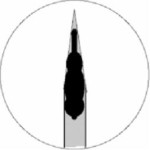 On the photo to the left, the shaded area is the blind spots to a horse. They can also use both eyes at the same time to see the same thing. That is called their Binocular Vision. [Bi=Two or both]
On the photo to the left, the shaded area is the blind spots to a horse. They can also use both eyes at the same time to see the same thing. That is called their Binocular Vision. [Bi=Two or both]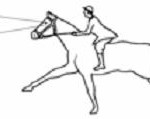
On the photo on the right, you can see how a horse needs to keep his head level to use his binocular vision, when running.
Understanding and remembering a horse’s vision limitations will help you to be more understanding the next time your horse spooks, is unsure or is bobbing his head.
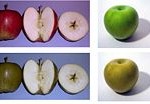 Another difference with a horse’s vision is their ability to see color. The photo on the left of the apples shows what we see and what a horse sees. The one with more color is what we [human predators] see, the shades [lacks color] is what a horse sees.
Another difference with a horse’s vision is their ability to see color. The photo on the left of the apples shows what we see and what a horse sees. The one with more color is what we [human predators] see, the shades [lacks color] is what a horse sees.
Since they see shades they are slower at recognizing things that may be common to us. They also may confuse things and not recognize common things as fast or as good as humans, so cut them a break.
Horse’s have more rods in their eyes which gives them much better night vision than us. However, their ability to adjust from light to dark is much slower than our human eyes.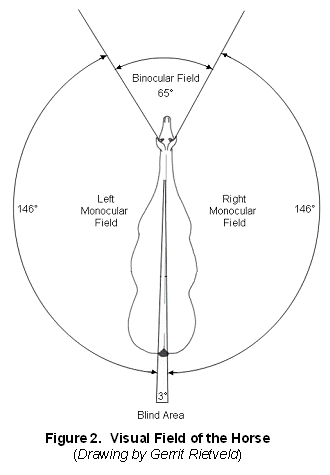
So moving a horse from light to dark areas, like barns, stalls, arenas or trailers, can be scary to them, since they lose their vision and it will appear almost pitch black, where they cannot see anything clearly.
This delay also happens when going from dark areas to light areas, which is why you need to aware of bright headlights, flash lights, bright lights around gates, arenas and pastures, sunsets or sunrise, etc.
This is another reason to slow down and try to understand when a horse stalls, balks or freezes up. A horse will always be a little more spooky as the sun sets since it takes up to 30 minutes or so for their eyes to adjust. As the sun sets, it creates more shadows which can confuse a horse when he is looking for predators or things that may eat him.
This spookiness and clumsiness can also be caused by the sun being low and glaring straight into the horse’s eyes or from a stupid human rider that is causing pain with a bit or spurs further making the horse more nervous and insecure. As a human we would put a hat on, hold our hand over our eyes to help us see or wear sunglasses, horses cannot do this, so they deal with the glare and blindness with confusion, spooks, tripping, head bobbing, fear and other things.
When a human cannot see we are not worried about being killed or eaten, a horse sees the world differently since their life depends on it. This is why I think horses react to White things since white reflects light and causes glare to horses so they tend to be concerned about white things.
Here are two identical pictures,
 the one on the left is what a human sees,
the one on the left is what a human sees, 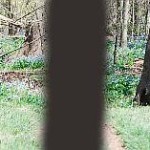 the one on the right is what a horse sees. Big difference and any reasonable person should be able to understand why a horse may be a little more nervous and moves his head so much and always seems to be trying to figure out things and may get spooked or confused, especially when the horse has a human yanking on his mouth, tying his head down and not allowing a horse to have his head.
the one on the right is what a horse sees. Big difference and any reasonable person should be able to understand why a horse may be a little more nervous and moves his head so much and always seems to be trying to figure out things and may get spooked or confused, especially when the horse has a human yanking on his mouth, tying his head down and not allowing a horse to have his head.
So when you hear people force a horse into a trailer and the horse acts scared and the owners yell and get upset with their horse, you will know that, the owner is the one being stupid and they are making the horse scared and not understanding why the horse is acting like it is.
To make this more understandably, remember when you walk into a movie theater and you have to stop and stand still for a few seconds until your eyes adjust. You may feel a little off balance or disoriented. Well our human eyes adjust within a minute or so. Imagine if when you walked into the theater and someone started pushing you and yelling at you or hitting you with a whip forcing you to move faster when you are somewhat blind.
It would not take long for you to start NOT to like walking into a theater or being around the dummy hitting or pushing you. Put yourself in your horse’s hooves. The more you learn about the horse the more you will start to Think Like A Horse and stop thinking like a know it all human.
NOTE: Most trailers are white so they reflect heat and stay cooler for horses. Horses tend to spook more at white things since that same reflection tends to blind, confuse or make it difficult for a horse to make out what they are seeing.
In the picture to the right you can see when someone holds a horse’s head down, on the bit, controlling the head, uses a tie down, uses draw reins, [sometime called fancy names like “Vertical Flexion”] all of these force a head down and interfere with the horse’s agility to adjust his head so he can see better, balance better and feel more comfortable. And people wonder why their horses don’t like shows or arenas or pain from a bit, seems pretty easy for me to understand why, can you?
when someone holds a horse’s head down, on the bit, controlling the head, uses a tie down, uses draw reins, [sometime called fancy names like “Vertical Flexion”] all of these force a head down and interfere with the horse’s agility to adjust his head so he can see better, balance better and feel more comfortable. And people wonder why their horses don’t like shows or arenas or pain from a bit, seems pretty easy for me to understand why, can you?
In the photo below you can the difference between what colors humans see and how horses see the same colors, this will explain why horses react differently to things and as horsemen we need to have understanding and help the horse understand and give the horse time to adjust to things differently than we do.
And finally a reminder picture that shows 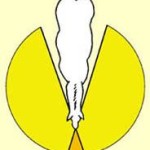 monocular and binocular vision of a horse and how limited their vision fields are.
monocular and binocular vision of a horse and how limited their vision fields are.
A “life long” horse owner will tell you “show the horse who is boss” and “make the horse respect your space” or “teach that horse some manners”
A real horseman (horsewoman) will help the horse, show understanding and compassion for the horse, knowing the horse is doing the best they can with the eyes and instincts they have.
The more you learn about the horse the more you will start to Think Like A Horse and stop thinking like a know it all human.
About the Author:
Rick Gore does what he does to help horses. Unfortunately, working with horses alone, does not help the horse in the long term. Having trainers work with your horse only teaches your horse. Unless YOU know what you are doing nothing will change.
Rick believes the owner or rider has to be taught how to understand the horse and work out things long term, rather than just training the horse. If you are local and within driving distance to Dallas, Texas, contact Rick and he will consider a visit. If you watch his videos and read his website site at http://www.thinklikeahorse.org, you will change and that will change your relationship with your horse.
If you are doing something for charity or helping rescue horses email you can email Rick and if he can help he will.
Email questions to Rick Gore at

